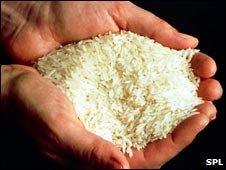White rice 'raises diabetes risk', say US experts
- Published

White rice has a higher glycaemic index than brown rice
Replacing white rice with brown rice and wholemeal bread could cut the risk of diabetes by a third, US experts say.
White rice poses a diabetes threat because it causes steep rises in blood sugar, say Harvard researchers in Archives of Internal Medicine.
Brown rice and other wholegrain foods are a healthier option as they release glucose more gradually, they say.
The study is based on questionnaires; some say the data is not robust enough to base firm conclusions on.
It may be that people who eat less white rice tend to live healthier lifestyles, for example.
'Brown is better'
In the study of nearly 200,000 US people, white rice consumption was linked to type 2 diabetes.
After adjusting for age and other diabetes risk factors, those who ate five or more 150g servings of white rice per week had a 17% increased risk of diabetes compared with people who consumed less than one serving - about a cup of rice - per month.
Although few people - only 2% - in the study ate this much white rice, the finding was significant.
Yet eating brown rice appeared to have the opposite effect, cutting the risk of type 2 diabetes.
People who ate two or more servings of brown rice per week had an 11% reduced risk of developing the condition compared with those who ate less than one serving a month.
Based on the results, the researchers estimate that replacing 50g or one-third of a typical serving of white rice with the same amount of brown rice would lead to a 16% lower risk of type 2 diabetes.
And replacing the white rice with wholegrains, including brown rice and pasta, wholemeal bread and rolled oats, could cut the risk by more than a third.
Food composition
Dr Qi Sun and other researchers say the explanation lies in the composition of the food.
Like other wholegrain foods, brown rice is high in fibre and releases its energy slowly.
In contrast, white rice has had all the bran and some of the germ removed during milling.
This gives white rice a higher glycaemic index (GI) - a measure of how much a food raises blood sugar levels compared with the same amount of glucose or white bread.
"From a public health point of view, replacing refined grains such as white rice by whole grains, including brown rice, should be recommended to facilitate the prevention of type 2 diabetes," according to the researchers.
Experts generally recommend that at least half of carbohydrate intake should come from whole grains like brown rice.
More than 70% of the rice consumed in developed countries such as the US and UK is white.
Dr Victoria King of Diabetes UK said that, since the results were from self-reported food diaries and questionnaires, it was not possible to make conclusive recommendations on how much of certain foods, such as brown rice, might protect against type 2 diabetes at this stage.
"The best way to prevent type 2 diabetes is by keeping active and eating a healthy balanced diet that is low in fat, salt and sugar with plenty of fruit and vegetables," she said.